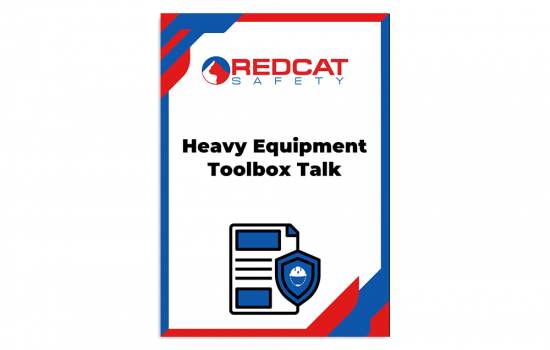About this Heavy Equipment Toolbox Talk
This heavy equipment toolbox talk can assist you to facilitate the elimination and reduction of hazardous interactions with the operation of powered heavy equipment.
A person with management or control of heavy equipment at a workplace must eliminate or reduce, as far as reasonably practicable all risks and hazardous interactions with the powered heavy plant.
Risk assessments should be completed on all heavy equipment within a worksite and those at risk with their interactions.
Conducting Pre-Start Checks
- It is mandatory that all powered heavy equipment and the work area is checked before operation and use.
- The operator must record any faults or safety issues that would deem the equipment unsafe.
- If unsafe to use, an out-of-service tag must be attached to the controls, noting the reason, time, date and name of the operator.
- Once the tag is attached, the defect or fault must be reported to a supervisor or person of authority who can initiate repair.
Safe Operation of Heavy Equipment

Any person who controls heavy equipment (except for cars) must:
- Be properly trained (including safe fueling or battery charging practices and operational procedures).
- Have current approved external licenses and approved internal certification where required.
- Have been assessed for competency by an approved assessor who is knowledgeable in the working environment, operation and condition of heavy equipment.
- Utilize any safety devices fitted to the heavy equipment such as seat belts, warning devices and speed limiters, etc.
- The operator must be aware of blind spots and workers should wear high visibility personal protective equipment on construction sites.
- Heavy equipment operators involved in an incident or near miss MUST report this immediately.
- Supervisors must check daily that all pre-start-up checks have been completed by heavy equipment operators.
- Moving equipment speed inside the working boundary must be no faster than a fast walking pace.
All necessary measures must be taken to ensure that heavy equipment does not:
- Overturn.
- Permit objects to fall on the operator of the heavy equipment. Rollover protection should be fitted to protect the operator.
- Allow the operator to be ejected from the heavy equipment.
- Collide with any person, structure or thing. Use hand signals where necessary when working around heavy equipment.
- Sustain mechanical failure of pressurized elements that may release fluids that pose a risk to the health and safety of workers.
Why Become a Member of Redcat Safety and Download this Heavy Equipment Toolbox Talk?
- Conducting toolbox talks on heavy equipment safety demonstrates an organization’s commitment to creating a safe work environment.
- The toolbox talk can reinforce a safety culture by prioritizing employee well-being, encouraging responsible equipment operation and fostering a sense of shared responsibility for workplace safety.
After downloading this heavy equipment toolbox talk you will be able to:
- Very easily edit and customize the template to create your own heavy equipment toolbox talk.
- Apply your own style, format and brand to the toolbox talk.
- Use it in any industry or sector regardless of size or type of organization.
Availability and Use of this Heavy Equipment Toolbox Talk
- This heavy equipment toolbox talk template is accessible to you right now by clicking the ‘Become a Member Now’ button.
- The toolbox talk will be delivered to you in fully editable Microsoft Word format for immediate and full use in your business.
- There are no membership auto-renewals, contracts or ongoing costs.

If you can find HSEQ resources that are of better value than what your Redcat Safety Membership offers, we will REFUND YOU double the cost of your membership.

